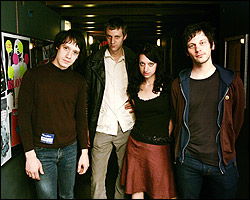On the screen before you, a bulldozer rolls languidly, as if playing the romantic lead in an ultramodern dance. The scene snaps, and a new one appears: Clouds cover a dull city skyline. The scene snaps again—it’s jarring; is it meant to be so jarring?—and next, the pages of a book flutter and flip by, reminding you of the way old movies portray the passage of time. Another snap, another 30-second scene, another snap. Artists fiddle with materials. Pedestrians become performers, unaware. Projected images camouflage the walls behind them. City streets, so universal they could be anywhere, seem disembodied from the earth. These scenes themselves are lithe and lovely even when they’re gray and empty, but a spliced-together stream of them is immusical. Discordant.
With these coincidental and yet somehow heavy moments passing by, you might be at the Whitney Museum’s recently opened, video-heavy Biennial in New York. You might be subject to the channel-surfing whims of a stranger in some waiting room or bar. But you’re at home; Saturday has just folded itself over onto Sunday morning and your television is tuned to Seattle Community Access Network (SCAN). You are watching the short films of local artist, activist, documentarian, and proto-blogger Rob Zverina.
We asked him: Are they meant to be so jarring?
“I hope it’sdisruptive and creates confusion for the viewer. ‘What the hell is this?’ I hope in some way it exposes the artificiality of the medium,” says Zverina. The nonsegues and cut-and-paste aesthetic are meant to wake you up.
“I hope my work functions as a brake on the headlong rush that is life,” Zverina continues via e-mail, “and perhaps encourages people to be more thoughtful and observant.”
If that sounds ambitious, check out Zverina’s Web site, which he calls Picture of the Day (www.zverina.com). On it, he catalogs (among other things) everyday ephemera culled from the salvage work he does for Ballard-based recyclers/resellers ReStore, poignantly getting at the waste of American consumerism. For example: An early morning photograph shows a charming 1940s bungalow softened by evergreens and dew. The text plainly and quietly explains that Zverina and his crew were there to dismantle it in order to make room for some new condos. Launched in 1998 before blogging was called blogging, the site utilizes the serendipitous nature of Web surfing to surprise you into thought. As with his SCAN show, Picture of the Day also effectively utilizes familiar formats—and, quite frequently, gorgeous, soothing images— to illustrate the cheerless nature of contemporary ignorance and modern need.
SCAN television reaches 500,000 cable households and is globally available via Web simulcast. About 400 surfers access Picture of the Day daily, generating a total of 500,000 hits since its launch; Zverina’s site has about 250 subscribers.
Of course, we’re all photographers now. Digital cameras—with their ease of use and increasingly affordable price—have transformed us all into Diane Arbuses and Michael Moores. Factor in sites like Flickr and YouTube, where we can post our images and movies for free, and we’re all self-publishing photographers now. But Zverina, a seven-year resident of Seattle, was born to Czechoslovakian political refugees and grew up with more photos of relatives than actual relatives. Like a lot of non-Westerners, his concept of time is partially shaped by the idea that “all moments are eternal (and thus simultaneous).” The images on his site and in motion on his show assert this. They are random and discordant, but harmonious.
“I think my documentation is an attempt to revert to a more childlike way of processing time and subvert the notion that “time marches on,'” he says.
Zverina belongs to a growing but unofficial movement of artists utilizing media to subvert and question media. In our interview, he borrows a line from activist and former Dead Kennedys vocalist Jello Biafra: “Don’t hate the media. Be the media.”
“The problem with mass media is not just the content of the programs, but that people have come to trust television more than the evidence of their senses,” says Zverina.
What’s remarkable about his work is that it attacks your senses and arrests your comfort, your ignorance, and your channel surfing, and yet, you still desire to trust it.








